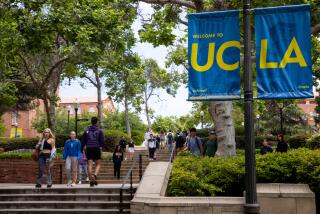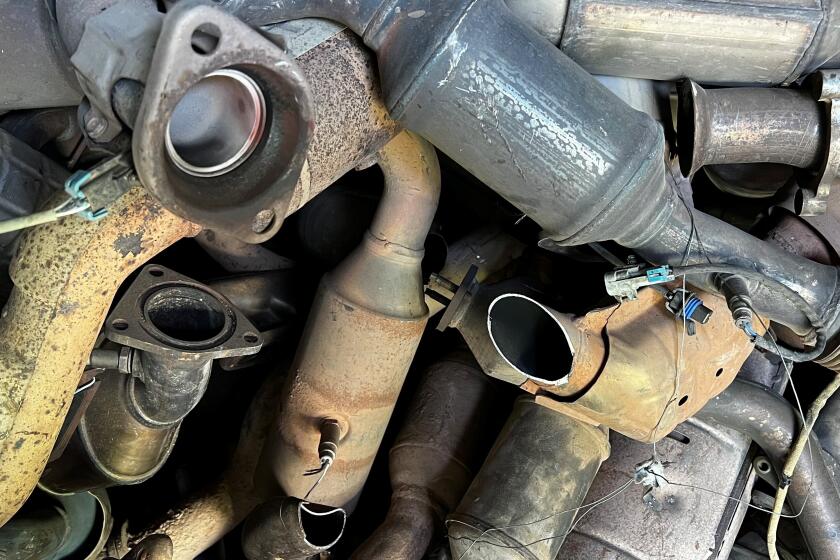CSUF Students : Study Lists Pressures on Vietnamese
- Share via
Vietnamese students--the largest foreign nationality group at Cal State Fullerton--have multiple academic pressures but few cultural resources on campus, a new study concludes. The study shows that pressures on Vietnamese students include large class loads of technical subjects and work at outside jobs. About 76% of the Vietnamese students are in the School of Math, Science and Engineering, and about 74% have jobs, the study says.
The students also feel strong family pressure to succeed academically, the study says.
There are about 1,100 Vietnamese among the 24,400 students at Cal State Fullerton. They are among 3,355 Asian students, the largest minority group on campus. Latino students make up the second-largest bloc, numbering 2,303. The 564 black students comprise the third-largest group.
But while the university has special programs for Chicano and black studies, there are no academic courses about the Vietnamese, the study notes. One of the study’s recommendations is that Cal State Fullerton start classes in Vietnamese language and history and ultimately establish a Vietnamese Studies Center.
“Since Orange County has about 90,000 Vietnamese residents, we have a golden opportunity” for Vietnamese academic studies, Robert B. Ericksen says. He is director of Cal State Fullerton’s Office of International Education and Exchange, which conducted the survey.
The survey is based on a questionnaire given to 379 Vietnamese students. The report, released this week, includes an analysis of the students’ answers.
More than half of the students said they would like to have tutoring and counseling.
Problems Making Friends
Although Vietnamese students say they want to be involved in campus life, the study says that making friends is difficult for them because of cultural differences.
“There seems to be a large-scale intercultural communication failure between the American and Vietnamese students on our campus,” the study says.
According to the study, U.S.-born students and faculty generally “do not perceive Vietnamese students as being friendly. On the contrary, there seems to be a strong feeling among the American students, faculty and staff that the Vietnamese students do not want to be part of campus life, nor do they want to associate with the American students.”
But the study found that the Vietnamese students do want to be assimilated into campus life. An overwhelming percentage (65%) of the Vietnamese students said they think they are already doing their best to make friends.
Meaning of Friendship
The study says cultural differences make it difficult for U.S. students to realize that the Vietnamese are trying to be friendly.
Moreover, the study says, friendship has different connotations in the two cultures.
“Friendship in the Vietnamese culture is a holistic concept, not a functional one,” the study says. “This means that when you are a friend of a person, you get involved in every aspect of this individual’s life.
“In the functional conception of friendship, one only deals with one aspect of the person, such as studying together, going to concerts together, going to church together, etc. Americans experience a great anxiety when someone demands a totally involving friendship, for they want to protect their privacy and individual independence. Therefore, Americans tend to develop functional friendships.”
Ericksen said a key finding of the study was that the Vietnamese students are emotionally torn between their new U.S. culture and their native culture. While most say they “want to gain a profession and learn American culture, history and language,” the Vietnamese students also strongly indicated that they are homesick for their native land.
About 83% of the students who took part in the survey say they missed relatives in Vietnam. But roughly the same percentage say they want to be “well-functioning, productive citizens of the United States.”
Ericksen said in an interview that he found that Vietnamese students feel bad whenever any Vietnamese is mentioned negatively in the press, such as in a crime. The study recommends that the university try to focus “positive recognition and media exposure for Vietnamese students.”
Other recommendations include involving more of the Orange County Vietnamese community in campus activities and hiring more Vietnamese faculty and staff members.
The study did not try to determine how well the Vietnamese students are doing with their college work. But previous studies of Vietnamese students, at all academic levels, have generally found them to be outstanding, hard-working students.
Ericksen said such findings perpetuate what he called “the myth of the model minority,” which he said assumes that all Asians, including Vietnamese, are automatically good students. The truth, Ericksen said, “is that Vietnamese students face the same range of pressures and stresses as all other students.”
Still, the study concludes that “there is a strong influence of the family on (Vietnamese) students’ lives.”
And Ericksen noted that Vietnamese parents highly regard the value of education and push their children for high grades.
The study had a preface that cautions against “stereotyping and overgeneralizing.” The study added:
“The students from Vietnam represent the full spectrum of degrees of acculturation. In our informal conversations with Vietnamese students, they have repeatedly stressed their desire to be treated as individuals, not as ‘Vietnamese students.’ ”
VIETNAMESE STUDENT PROFILE
Vietnamese students make up the largest foreign nationality group at Cal State Fullerton with about 1,100. A recent survey of just over 379 Vietnamese students at CSUF indicates that three-fourth of them work and a like number are also enrolled in the School of Math, Science and Engineering.
EMPLOYMENT
Number of students not employed . . . 26%
Number of students employed . . . 74% SCHOOL/COURSE OF STUDY
Math, Science and Engineering . . . 76%
Business Adm. and Economics . . . 18.9%
Other . . . 2.8%
Humanities/Social Sciences . . . 1.6%
Arts . . . 0.6%
SOURCE OF INCOME
Self . . . 50.3%
Scholarship (Financial Aid) . . . 29.7%
Family . . . 13.3%
Other . . . 6.8%
SOURCE: Office of International Education & Exchange, Cal State Fullerton
More to Read
Sign up for Essential California
The most important California stories and recommendations in your inbox every morning.
You may occasionally receive promotional content from the Los Angeles Times.










